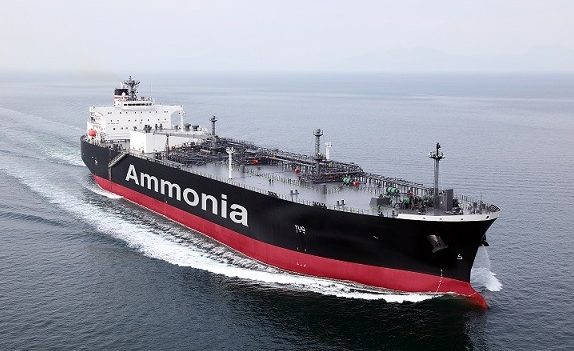Maersk, NYK and Total among big names setting out to make ammonia a safe fuel choice for shipping

This week, Lloyd’s Register’s Decarbonization Hub, A.P. Moller-Maersk, MAN Energy Solutions, Mitsubishi Heavy Industries, NYK Line, Total and the Mærsk Mc-Kinney Møller Center for Zero Carbon Shipping are joining forces in a new project with the purpose of guiding safe use of ammonia as a fuel for shipping.
Ammonia as a fuel is heavily debated as a suitable long term solution for maritime, as the industry transitions towards a zero- or low carbon value chain. Green ammonia can be produced from renewable power by electrolysis of H2O, ultimately making it a zero carbon fuel. However, due to the extreme toxicity of the fuel, it is critical to address the safety issues of ammonia in order to mitigate risks for both people, assets and the environment.
One small leak on a ship equals 20 funerals
To accelerate the safe introduction of ammonia in maritime, the partners in the new venture agree it is critical to create clarity, assess the safety challenges and need for global standards. Part of this will include developing a mature and detailed understanding of risk and safety concerns, which will be assessed through a quantitative risk assessment methodology in phase one of the project. This will ultimately lead to the development of best practices for safeguards in design and arrangements when using ammonia as a shipping fuel.
The project will also determine the risk of fatality from unintended releases of ammonia, as well as the risk contribution of key equipment and spaces dedicated to ammonia storage. To illustrate the potential for risk mitigation measures, the project partners will assess alternate vessel designs, optimised to be fuelled by ammonia.
Funded by the participating partners, the project will be managed by the Mærsk Mc-Kinney Møller Center for Zero Carbon Shipping and is expected to run throughout 2021.
Safety must not become an afterthought
“In the eagerness to decarbonise the shipping sector proper risk management is critical and safety must not become an afterthought,” said Claus Winter Graugaard, head of onboard vessel solutions at the Mærsk Mc-Kinney Møller Center for Zero Carbon Shipping.
“Safe operations of ammonia as a fuel is the most important prerequisite to successfully design and deploy ammonia powered vessels. At Maersk we see green ammonia as one of the fuels of the future. It emits no CO2 during combustion and offers a very promising scalability potential. Besides the technical challenges, ammonia’s safety challenge is a main outstanding hurdle to solve for ammonia to become a viable ship fuel, so we are very pleased to team up with leading players across the ecosystem in solving ammonia’s safety challenge,” said Ole Graa Jakobsen, head of fleet technology at A. P. Moller – Maersk.
Ammonia is what makes fertiliser, a filthy smelling and potentially explosive material.
Many crew who have experience of handling ammonia – a toxic, nauseous substance – are naturally aghast at the idea that one day thousands of ships could be powered by it.
One regular Splash reader warned of the perils of pursuing ammonia as a fuel for vessels, tweeting: “One small leak on a ship equals 20 funerals and don’t even get me started on what it would do if it leaked into the water.”
Earlier this month one crew member died and another three were critically ill after inhaling ammonia gas on the LPG tanker Hamburg DW off Malaysia.

Who are we to question amonnia or any other energy? Owners and politicians will bring amonnia on board, and skepticals will be left behind.
Ammonia was used as the refrigerant on the first generation of reefer ships. Occasional incidents but not really so many.